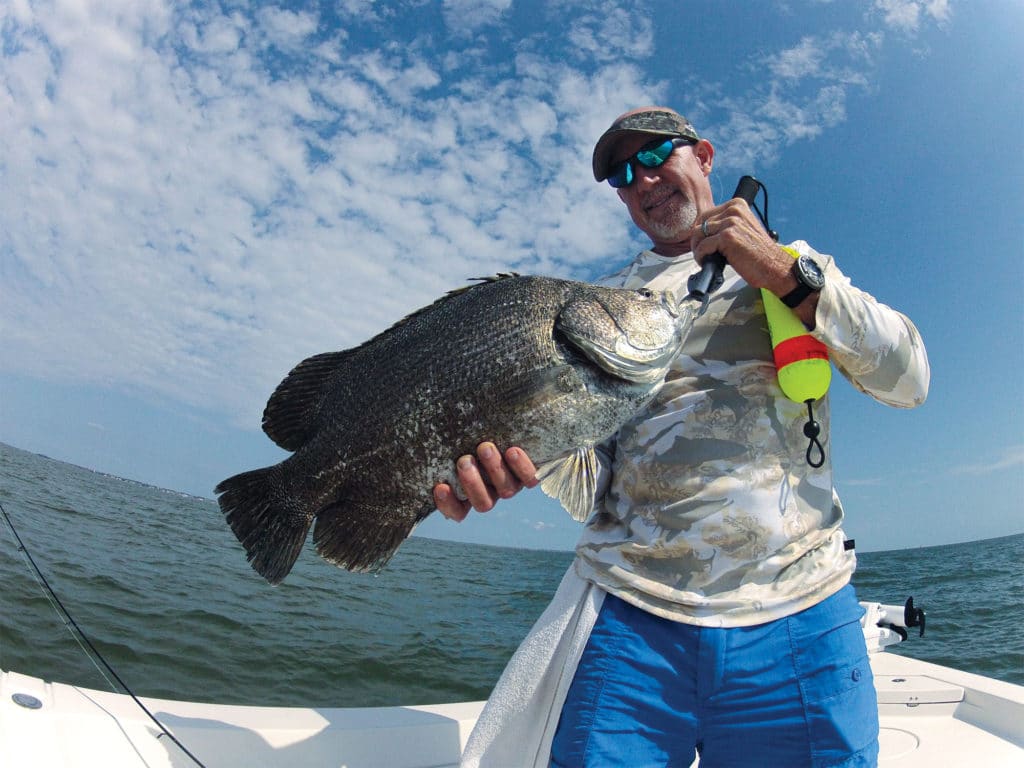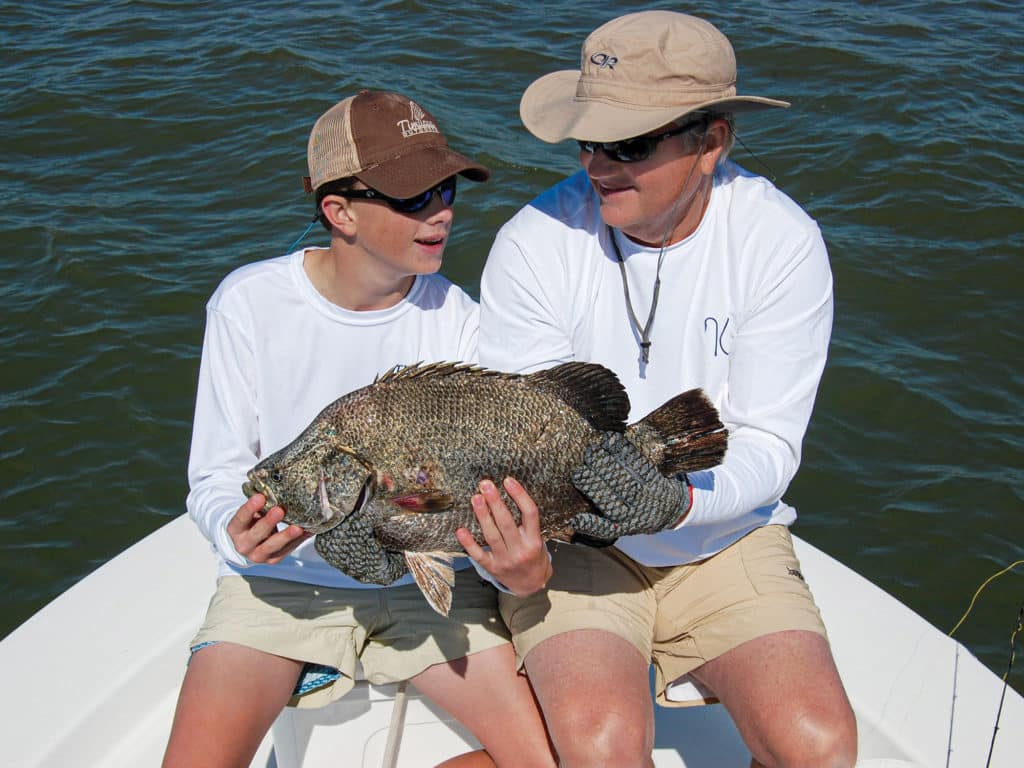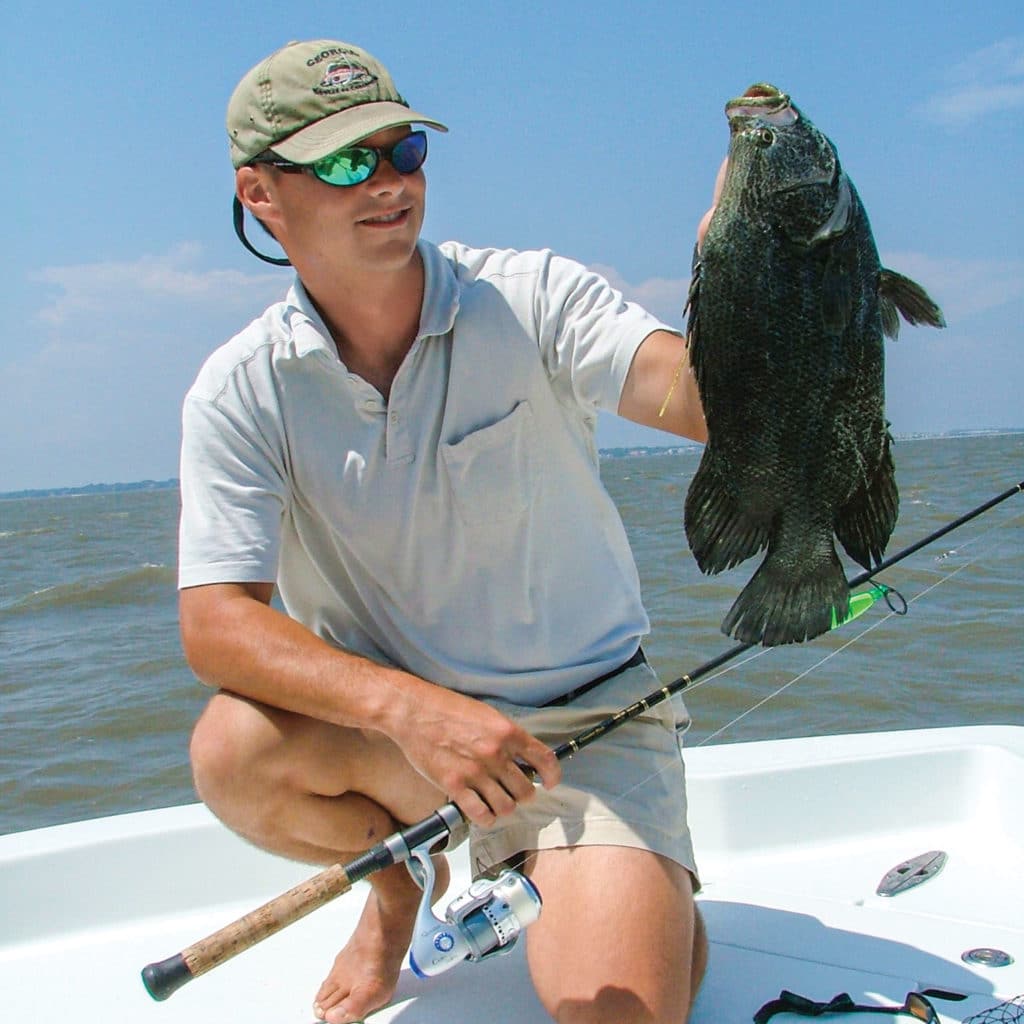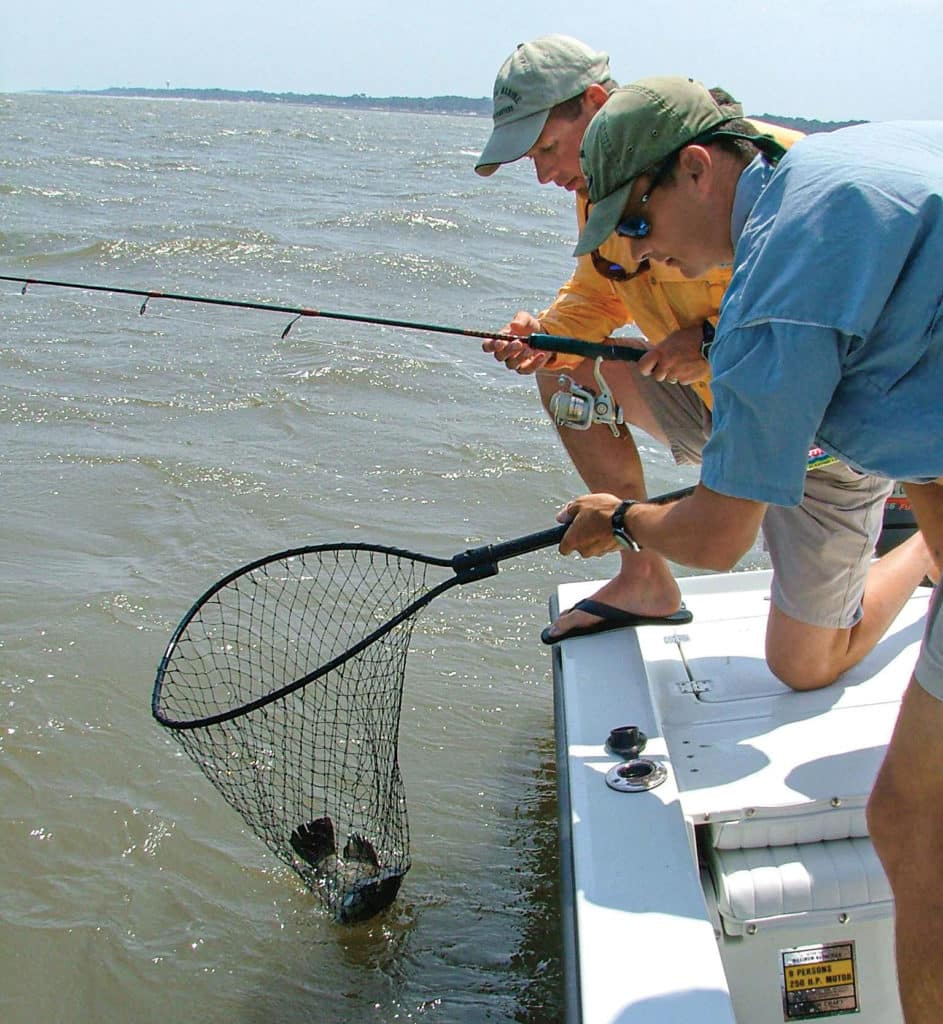
“Three o’clock, 30 yards!” I shouted from the elevated second helm as we idled through the shallow waters off Jekyll Island, Georgia. “I see it,” said my friend before making a cast toward the tripletail floating on its side under the May sun. Carefully, he pulled the live shrimp beneath his popping cork into the path of the fish.
Sensing the presence of the bait, the tripletail submerged. “He’s under the float,” I confirmed. “Free-spool the bait so it stays with the fish as we drift,” I requested.
Seconds passed like hours before the float quivered slightly, disappeared and then surfaced behind the greyhounding tripletail. Five minutes and several strong runs later, the hefty fish came to net.
“About 15 pounds,” I said, lifting the legal fish and placing it onto the ice.
“Let’s do that again,” my friend chimed, and the hunt resumed. We spotted another 20 fish, cast to half of them, and brought five to the boat, including another nice keeper.
Beloved Invader
The tripletail gets its name from its dorsal and anal fins, which make the fish appear to have three tails. This configuration along with a broad, muscular body make the tripletail a tough opponent. Imagine a 10-pound bluegill that somersaults like a dolphin and fights like an amberjack.
Each spring, tripletails migrate northward from Florida, congregating in the warming Atlantic Ocean waters east of Jekyll Island. While similar areas exist along the Georgia coast, no other place draws tripletails in such numbers—and no one yet knows why.
When water temperatures climb into the mid-60s, the hunt begins. Anglers start catching tripletails in late March, with abundance peaking from April through June, and a few fish lingering through the summer.
Contrary to the fish’s typical behavior of orienting to fixed structures such as pilings and buoys, these tripletails float in open water. When conditions are right—light winds and sunny skies—and the tripletails are not bashful, you might see dozens of fish from 12 to 30 inches on the surface in a couple of hours. Pursuing them has become a rite of spring, offering one of the Peach State’s most exciting and sometimes frustrating sight-fishing opportunities.
Historically, the most productive area lies between the Brunswick ship channel to the north and the Jekyll Island Convention Center to the south approximately 5 miles, where anglers spot tripletails within a few hundred yards of the beach at high tide and 3 to 4 miles offshore at lower tide stages.

The Eyes Have It
As a rule, sight-fishermen avoid hunting in groups, but not so with tripletails. The more people scanning the water, the greater the odds of spotting fish. I’ve had some of my best days with a boatload of watchful anglers whose sharp eyesight kept us in constant action, with the occasional double and even triple hookup. Be sure to use high-quality, polarized eyewear and a broad-brimmed hat to reduce glare and enhance vision.
Spotting the first fish can be difficult for novices but becomes easier with practice. Typically, the tripletail is a drab, mottled-brown but free-swimming fish that often appears bright white, making it visible from a great distance when horizontal on the surface. Other times, the fish swims vertically, making it more difficult to spot just below the water. You might only see the dark dorsal and tail fins.
Give everything you see a close inspection. What appears to just be debris or a jellyfish frequently turns out to be a tripletail.
Most anglers focus their search from 9 a.m. to 3 p.m., when the sun sits well above the horizon. Boats with an elevated second helm combine a height advantage for spotting fish with the ability to quickly maneuver into casting range. Poling platforms, hardtops, and even stepladders secured by ratchet straps all elevate anglers, serving the purpose.
To best locate tripletails, motor slowly on a heading that keeps the surface glare abeam and astern. Once they see a fish, some anglers prefer to put the boat in neutral and drift, while others continue underway but tighten their search area. Trolling motors allow a stealthy approach, while outboards permit a quicker response and greater maneuverability.

Make Them Bite
While small menhaden and finger mullet will draw strikes, a live shrimp just below the surface works best. A chartreuse popping cork with a 1/2-ounce trolling weight connected to the bottom barrel swivel with a stainless-steel split ring and 12 inches of 20-pound fluoro ending in a 1/0 wide-gap or Kahle hook makes the rig.
Once the cork lies in the path of the fish, I don’t move the bait. The live shrimp swimming provides sufficient attraction. Shrimp imitations also can be effective when paired with a popping cork. A subtle twitch of the cork attracts the attention of hungry tripletails, but aggressive action will often spook them.
When winds are light, and the fish are pressured and skittish, I opt for a weight-integrated, 3 1/2-inch cigar-shaped float in chartreuse or orange on 20 inches of 20-pound fluoro tied to the braid’s main line. I then add the hook on 12 inches of leader to the float. This stealth rig casts like a bullet and lands like a butterfly with sore feet.
Small- to medium-size topwater lures worked across the path of tripletails suspended on the surface also produce strikes when the fish are aggressive. Flies that imitate crabs, shrimp and small baitfish—in natural colors—also take their share of tripletails.
Read Next: Pan-Roasted Tripletail

Tips for Trips
Along with patience, the key to connecting with free-swimming tripletails is teamwork. The helmsman ensures the boat stays in casting range without spooking the fish. The angler puts the rig in the right spot, prepared to make a second cast if fish behavior, wind, current or boat movement foils the presentation.
Tripletails commonly make a sudden appearance within casting range, which demands a quick cast. I keep rods rigged at the bow, stern and elevated helm, with the live shrimp in a bucket of seawater.
Free-swimming tripletails wrote the book on peculiar behavior. Some will take the bait instantly, even striking the cork. Others study the shrimp and inspect it closely before moving on.
Sometimes a second or third presentation will trigger a response, but too many times the stubborn tripletail shows total disdain. Most frustrating are those that somehow manage to pick the shrimp off the hook without the slightest movement of the float.
The appeal of fickle free-swimming tripletails brings scores of anglers to Jekyll Island each year. Thanks to careful management, abundance is holding steady, ensuring a productive hunt for the wily and delicious species in south Georgia.
Traveling Tripletails
In Georgia, the importance of tripletail to anglers makes the species a priority for the Department of Natural Resources. More than 2,000 have been tagged, and recaptures shattered notions that tripletails randomly scatter in the Atlantic. A tripletail tagged and released just off Jekyll Island on June 1, 2009, was recaptured 372 days later within 1 mile of where it had been let go. The fish had grown from 16 to 24 inches. Several fish tagged with sonic transmitters in Georgia were found during the winter and early spring in Florida, from Port Canaveral to West Palm Beach. Scientists surmise that tripletails appear off Georgia in March and remain until fall. As water temps drop, they move south, reaching central Florida by November, and Jupiter and West Palm Beach by January. They stay in this area until the end of
February, then move back north. Both states have the same 18-inch minimum size and two-fish limit.
SWS Planner: Georgia Tripletail
- What: Tripletail
- Where: Jekyll Island, Georgia
- When: March through July
- Who: This fishery is available to everyone, but for the finer points of tripletail hunting, these experts stand ready:
- Capt. Greg Hildreth; Brunswick, Georgia; 912-617-1980; georgiacharterfishing.com
- Capt. Jay Childers; St. Simons Island, Georgia; 912-230-2473; jaybirdfishingcharters.com
- Capt. Tim Cutting; St. Simons Island, Georgia; 912-270-1814; fishthegeorgiacoast.com
SWS Tackle Box
- Rod: 7-foot G.Loomis E6X medium-heavy, fast action
- Reel: Penn Conflict 3000 spinning, or equivalent
- Line: Power Pro Super 8 Slick, 20-pound in aqua green
- Terminal Rig: Popping cork, 20-pound fluorocarbon leader, Eagle Claw Lazer Sharp L141 Kahle hook in size 1/0









